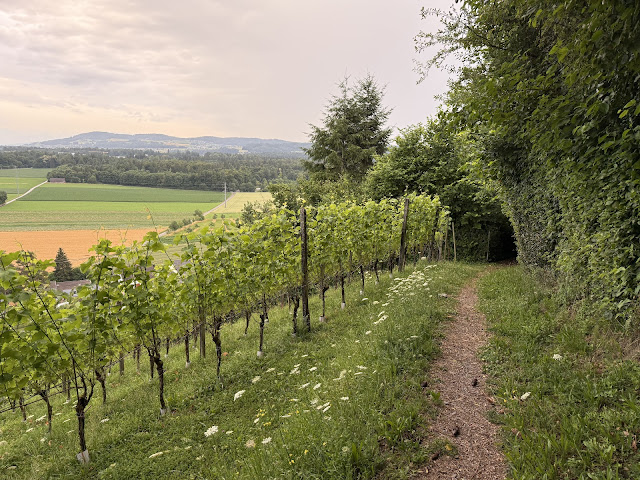 |
| Photo Credit: Steffi Wacker on Pexels |
I was today years old when I realized (some) birds still sing in the rain.
Recently, I interviewed a gentleman from the Swiss Ornithological Institute for our town magazine. He told me he was delighted and surprised to spot a rare bird practically on my doorstep: the pied flycatcher. Intrigued, I looked it up and discovered that this long-distance migrant is a fascinating species, even though it’s increasingly disappearing from our region. It’s not considered endangered, but it is under pressure.
Here’s why:
The pied flycatcher winters in the tree savannas of the Sahel, just south of the Sahara, and returns to Europe in spring to breed. But climate change is disrupting the rhythm of its ancient schedule. Spring now begins earlier, which means oaks and other trees sprout sooner—and caterpillars, the primary food source for flycatcher chicks, hatch earlier too.
But the pied flycatcher doesn’t migrate based on weather in Europe. Its cues come from daylight length and climate signals in Africa. So even though the birds now return a little earlier than they used to, they still often miss the caterpillar peak. Scientists call this a “food mismatch”: a temporal misalignment between breeding and food availability.
To make matters worse, the pied flycatcher is facing increased competition from resident species like the great tit, which are already here to claim food and nesting sites. In commercially managed forests, there’s often a lack of old trees with cavities - essential for flycatcher nests.
This combination of food scarcity, competition, and habitat loss forces many of them to seek new breeding grounds—often in cooler, higher-altitude areas like the Swiss Alps or Scandinavia, where spring arrives later and things are more in sync.
Long story short, my curiosity was piqued.
After two rough nights of sleep, I went to bed early and woke up - refreshed - at 5 a.m. The birds were already singing in our garden. Thanks to the Merlin app (which the ornithologist recommended), I could identify them: blackbirds, blackcaps, black redstarts, blue tits, chaffinches, crows, sparrows, the usual chorus.
It was raining, but I was determined to go out anyway. If the birds didn’t care, why should I? The pied flycatcher may not love wet weather, but the forecast promised only occasional thunderstorms.
I wore my olive-green safari pants from South Africa - still going strong after all these years - and instead of my cheerful, multi-colored, mood-lifting umbrella, I grabbed the transparent one I bought for an Elf-on-the-Shelf project last Christmas (don’t ask). I wanted to blend into the woods.
It was interesting to watch the scenery shift with the weather. While the rain came and went, the blackbirds, blackcaps, and robins kept singing most consistently.
When it cleared a bit, my app picked up a blue tit, a chiffchaff (never even heard of that before), a buzzard (I knew that one!), a black kite, and a swift.
I arrived at an area that was marked as an old-growth island. This area is even specifically protected by our canton because natural ageing and decay processes should be able to take place there. This is primarily for the benefit of certain animal and plant species.
The biologist had explained to me that specifically this type of landscape was ideal for the pied flycatcher. This is where these birds find breeding sites in tree hollows.
But my app didn’t register anything close to a flycatcher.
Instead, I heard a strange sound - almost like scaffolding being shaken. Or cats hissing at each other. Very uninviting.
I found a video, the sound starts at 0:39:
Apparently imitating other creatures like cats is his superpower.
Speaking of cats: I probably startled one on the prowl myself.
I quickly recorded the eerie sound with the app.
“Eurasian jay,” it said. (Picture at the top of this post)
Curious, I looked it up. Turns out the colorful jay is famous for its loud screeches. It’s vigilant and watchful, sort of the police officer of the bird world. Its warning calls alert not just its own kind but other birds too. In fall, it hoards nuts and acorns, many of which it forgets, leading to new tree growth. So yes, the jay is also an unintentional forest gardener.
I always say I didn’t pay much attention in natural history class. But the interview, my research, and this morning’s walk have officially promoted me to the “interested and intrigued” category.
I mean - what these birds do is nothing short of extraordinary. The journey to Africa and back! The navigation, the endurance, the survival instinct. And all that just to lay a few eggs, search for food nonstop, fend off predators, and then do it all again.
Respect.
I hope I remember that the next time I whine about my mental load or what to cook for dinner.
 |
| Photo Credit: Felix Rehm on Pexels |
I didn’t spot a pied flycatcher (see picture above), but I had an enchanting experience nonetheless. And who knows - maybe I’ll wake up early again this weekend and get another chance.
What’s the most surprising thing nature has taught you lately?


Comments
Post a Comment
Thank you for your comment. It will be visible as soon as I had a chance to verify that you are not an anonymous user and/or a spammer.